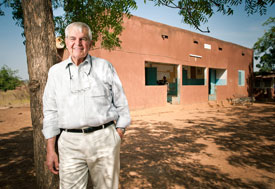NIH aids effort to produce meningitis vaccine for Africa
November / December 2011 | Volume 10, Issue 6
In the so-called "meningitis belt" of sub-Saharan Africa, the disease spreads during the dry season and millions of the afflicted await the "rains of hope" that curb that year's epidemic. Now, an innovative, groundbreaking partnership has become its own rainmaker, producing a safe, inexpensive, long-lasting vaccine that offers hope to end Group A meningococcal epidemics.
The story of the development of the new vaccine, MenAfriVac (TM), was related in stirring detail during a presentation at NIH by Dr. F. Marc LaForce, director of the Meningitis Vaccine Project (MVP), a partnership between PATH and the WHO. Within a few short years, the vaccine was developed, approved and introduced at a cost of less than 50 cents a dose, a perhaps unprecedented achievement.
Bacterial meningitis is an infection of the thin lining surrounding the brain and spinal cord. In the 25 countries of the African meningitis belt, which stretches from Senegal in the west to Ethiopia in the east, more than 400 million people are at risk of brain damage, profound hearing loss or death. As many as 10 percent of those infected will die and one in every four survivors has severe hearing impairment or mental deficiencies.

Photo courtesy of PATH/Gabe Bienczycki
Dr. Marc LaForce, director of the Meningitis
Vaccine Project, worked with NIH and other
partners for nearly a decade to produce and
distribute a cost-effective vaccine in Africa.
"There's an enormous amount of disease caused by this pathogen," said LaForce, who added that 90 percent of the world's disease burden of serogroup A meningitis occurs in these countries. An outbreak in 1996-97 infected 250,000 people and more than 25,000 died.
In an effort to produce a serogroup A conjugate vaccine, the public-private partnership called MVP was established, with support from the Bill and Melinda Gates Foundation. The Serum Institute of India, agreed to produce the new vaccine for less than 50 cents. SyncoBioPartners in the Netherlands and the Serum Institute provided raw materials for the vaccine.
The NIH helped transfer the conjugation technology, developed by the FDA, to the Serum Institute at almost no cost - a sensitive proposition as it involved the transfer of intellectual property, LaForce noted.
Overall, the new vaccine, MenAfriVac(TM), cost a fraction of the $500 million usually required to manufacture and bring a new vaccine to market. The drug was cleared by India in Dec. 2009 and qualified by WHO in June 2010. And then the real miracle occurred.
On Dec. 6, 2010, in Burkina Faso, Mali and Niger, children and young adults - the disease strikes those mainly under 29 years of age - began being vaccinated. "We have an opportunity to change the health of the country," the president of Burkina Faso said at a ceremony marking the occasion. Within 10 days, 10.8 million persons were immunized.
"This was utterly remarkable," said LaForce.
Six months after introduction, Burkina Faso, Mali and Niger report the lowest number of confirmed meningitis A cases recorded during an epidemic season. There were 2,624 cases reported in Burkina Faso in 2011, compared with 26,878 in 2007.
LaForce said the vaccine "proved to be therapeutic and greatly shortened the carriage rate" - the amount of time the pathogen is harbored within the body.
WHO and PATH are working to build support for sustaining the immunization effort and expanding it by 2016 to the 22 countries where people have yet to receive the vaccine. If successful, the "rains of hope" may become a footnote - not a fix - for the disease.
More Information
To view Adobe PDF files,
download current, free accessible plug-ins from Adobe's website.